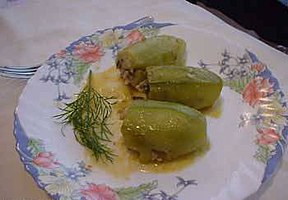
Turkish cuisine is the cuisine of Turkey and the Turkish diaspora. It is largely the heritage of Ottoman cuisine, which can be described as a fusion and refinement of Mediterranean, Balkan, Middle Eastern, Central Asian and Eastern European cuisines. Turkish cuisine has in turn influenced those and other neighbouring cuisines, including those of Southeast Europe (Balkans), Central Europe, and Western Europe. The Ottomans fused various culinary traditions of their realm taking influences from and influencing Mesopotamian cuisine, Greek cuisine, Levantine cuisine, Egyptian cuisine, Balkan cuisine, along with traditional Turkic elements from Central Asia, creating a vast array of specialities. Turkish cuisine also includes dishes invented in the Ottoman palace kitchen.

Tripe is a type of edible lining from the stomachs of various farm animals. Most tripe is from cattle, pigs and sheep.
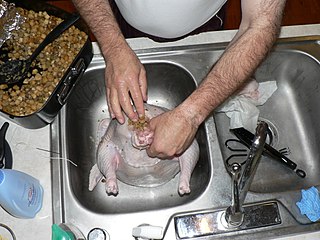
Stuffing, filling, or dressing is an edible mixture, often composed of herbs and a starch such as bread, used to fill a cavity in the preparation of another food item. Many foods may be stuffed, including poultry, seafood, and vegetables. As a cooking technique stuffing helps retain moisture, while the mixture itself serves to augment and absorb flavors during its preparation.

The zucchini, courgette or baby marrow is a summer squash, a vining herbaceous plant whose fruit are harvested when their immature seeds and epicarp (rind) are still soft and edible. It is closely related, but not identical, to the marrow; its fruit may be called marrow when mature.

Moussaka is an eggplant- or potato-based dish, often including ground meat, which is common in the Balkans and the Middle East, with many local and regional variations.
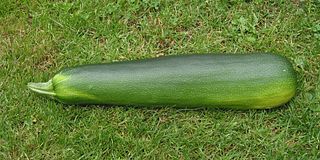
A marrow is a fruit used as a vegetable, the mature fruit of certain Cucurbita pepo cultivars. The immature fruit of the same or similar cultivars is called courgette or zucchini. Like courgettes, marrows are oblong, green squash, but marrows have a firm rind and a neutral flavour, making them useful as edible casings for mincemeat and other stuffings. They can be stored for several weeks after harvest, to be processed for food when required. They are a vegetable used in Great Britain and areas with significant British influence, though their popularity is waning in favor of immature summer squash like courgette.

Kibbeh is a family of dishes based on spiced ground meat, onions, and grain, popular in Middle Eastern cuisine.
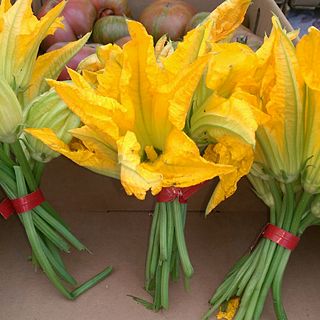
Squash blossoms are the edible flowers of Cucurbita species, particularly Cucurbita pepo, the species that produces zucchini (courgette), marrow, spaghetti squash, and many other types of squash.

Iraqi cuisine or Mesopotamian cuisine is a Middle Eastern cuisine that has its origins from Sumerians, Akkadians, Babylonians, Assyrians and the other groups of the region.
Bosnia and Herzegovina cuisine is balanced between Western and Eastern influences. The food is closely related to former Yugoslav, Middle Eastern, Mediterranean, Austo-Hungarian and other Balkan cuisines.

Stuffed peppers is a dish common in many cuisines. It consists of hollowed or halved peppers filled with any of a variety of fillings, often including meat, vegetables, cheese, rice, or sauce. The dish is usually assembled by filling the cavities of the peppers and then cooking.

Palestinian cuisine consists of foods from or commonly eaten by Palestinians, whether in Palestine, Israel, Jordan, refugee camps in nearby countries, or by the Palestinian diaspora. The cuisine is a diffusion of the cultures of civilizations that settled in the region of Palestine, particularly during and after the Islamic era beginning with the Arab Ummayad conquest, then the eventual Persian-influenced Abbasids and ending with the strong influences of Turkish cuisine, resulting from the coming of the Ottoman Turks. It is similar to other Levantine cuisines, including Lebanese, Syrian and Jordanian.

Neapolitan cuisine has ancient historical roots that date back to the Greco-Roman period, which was enriched over the centuries by the influence of the different cultures that controlled Naples and its kingdoms, such as that of Aragon and France.

Seon is a traditional Korean dish made from steamed vegetables such as zucchini, cucumber, eggplant or Napa cabbage and stuffed with meat. Although the term is a counterpart of jjim — a category of dishes that are made by steaming meat or seafood — the concept is not clearly settled.

The cuisine but being claimed as of Algeria is influenced by Morocco interactions and exchanges with other cultures and nations over the centuries. It is characterized by a wealth derived from both land and sea products. Conquests or demographic movement towards the Algerian territory were two of the main factors of exchanges between the different peoples and cultures. This cuisine is a Mediterranean and North African cuisine with Berber roots.

Eggah is an egg-based dish in Arab cuisine that is similar to a frittata. It is also known as Arab omelet. Eggah is commonly seasoned with spices such as cinnamon, cumin, coriander seeds or leaves, turmeric, raisins, pine nuts, nutmeg and fresh herbs. It is generally thick, commonly filled with vegetables and sometimes meat and cooked until completely firm. It is usually circle-shaped and served sliced into rectangles or wedges, sometimes hot and sometimes cold. Eggah can be served as an appetizer, main course or side dish.
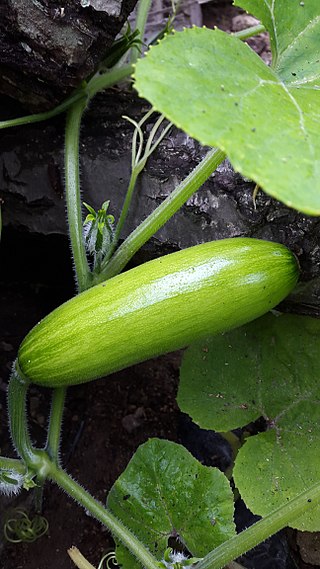
Aehobak, also called Korean zucchini or Korean courgette, is an edible, green to yellow-green summer squash. Although nearly all summer squashes are varieties of Cucurbita pepo, aehobak belongs to the species Cucurbita moschata. Commonly used in Korean cuisine, an aehobak has the shape of zucchini, but with thinner, smoother skin, and more delicate flesh. It is usually sold in shrink-wrapped plastic.
